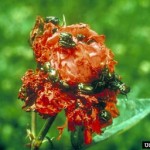
Japanese beetles on rose. Photo by M. G. Klein, Bugwood.org
What is a Pesticide?
A pesticide is any substance or mixture of substances intended for preventing, destroying, repelling or mitigating any pest. (Source: EPA)
Pesticides often refer to the type of pest they control, e.g. insecticides kill insects and other arthropods; miticides or acaricides kill spider mites.
All pesticides are regulated by the Environmental Protection Agency (EPA). However, multicellular animals used to control insect pests (e.g., parasitic nematodes) are not regulated by EPA as pesticides/insecticides.
There are two broad categories of insecticides:
- Microbial insecticides (those containing containing bacteria, fungi, viruses)
- Chemical (both natural and synthetic)
Types of Pest Control
- Biological Control agents (bacteria, fungi, viruses) formulated as microbial insecticides
- Chemical Control
- Organic – What does the term “organic” mean?
- Botanical (plant-derived)
- Fermentation Products (spinosad, abamectin)
- “Near-organic” and “Inorganic” Insecticides
- Organic – What does the term “organic” mean?
Pesticide Regulations
Insecticide use is regulated by the Environmental Protection Agency’s Federal Insecticide, Fungicide, and Rodenticide Act (FIFRA ) and the Texas Department of Agriculture (TDA). Texas A&M AgriLife’s Agriculture and Environmental Safety project group can provide answers about proper pesticide use and disposal.
- The law mandates that pesticides be used according to label directions with a few exemptions A person can use an insecticide for pests not listed on the product label as long as the use site is listed. Section 2(ee) of FIFRA (page 13) allows for the use of any registered pesticide “against any target pest not specified on the labeling if the application is to the crop, animal, or site specified on the labeling…” Thus, if a particular insect like a borer beetle is not listed on a product labeled for use on trees and shrubs but others are listed, or other products include mention of those pests, that product may be used to try to control the unlisted pest.
- Some products claiming insect control now being sold may not be registered by the EPA because of an exemption described in Section 25 (b), page 89 and Pesticide Registration (PR) Notice 2000-6.
